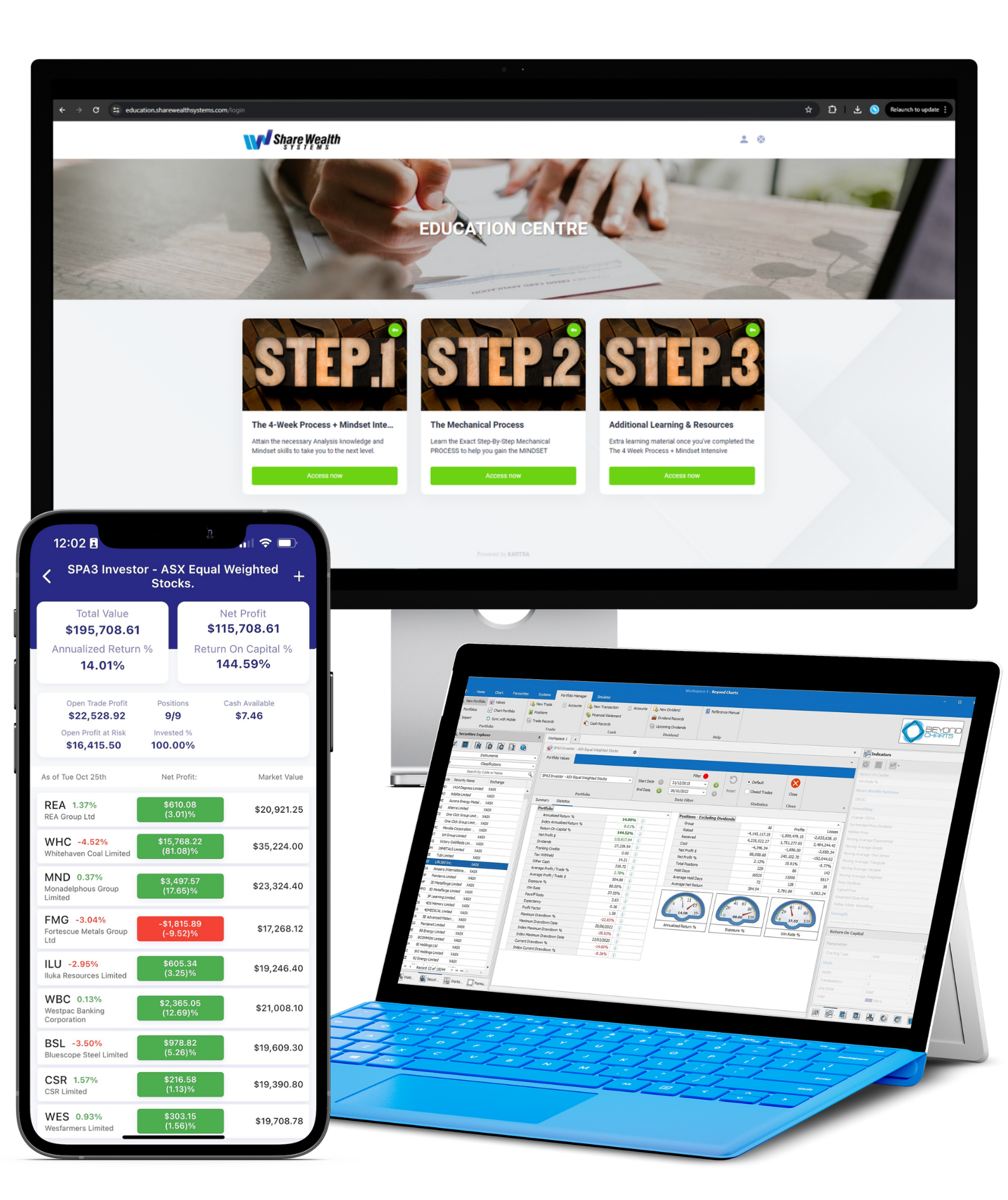 | From the Share Wealth Systems R&D Team |
_
If you read the previous journal, you’d be aware that I’m ready to disclose research my team and I have worked on for the better part of 2011 – research that excites me greatly.
My hope is that as you work through this you’ll experience that light bulb moment when everything clicks. That shift in perspective and paradigm that allows you to see things differently. The Japanese call it ‘Satori’ which literally means “understanding”. It is often referred to as an ’AH-HA’ moment – when you suddenly ‘get’ something you have not been able to see or grasp before.
Whilst the research is specific to SPA3, I will use it as an example environment that I hope will challenge you and make you question how far your learning has to go when it comes to investing your money in the market.
Introduction to the Research
“The most important preparation a trader can do is to make as certain as possible that he [or she] has a positive mathematical expectation in the future.” Ralph Vince – author of “The Mathematics of Money Management” and “Portfolio Management Formulas”.
Back in the mid to late 1990’s when SPA3 was first researched and then released, ensuring a positive mathematical expectation was a major objective. As were the position sizing and risk management rules that have been devised over the years for SPA3.
However, we have taken Ralph Vince’s quote a step further and have determined that the most important preparation a trader can do is to:
-
- make as certain as possible that their trading system has a positive mathematical expectation in the future,
- ensure that resultant trades from the trading system have as low as possible standard deviation of trade outcomes,
- devise a risk management and money management regime that best matches the quality and characteristics of the trading system and the trader’s reward and risk objectives, and
- conduct portfolio level risk and money management exploratory simulation over a period of time that includes different types of markets including up, down and sideways markets.
The step further is the portfolio level risk and money management exploratory simulation. As important as Ralph Vince’s statement is, this set of blogs will hopefully demonstrate that the exploratory simulation is even more important than just having a positive mathematical expectation.
Objectives of the Research
As SPA3 is an existing methodology, objectives had to be set for the revision exercise.
The first and main objective was to improve performance. Improving performance has a number of inter-related objectives. The obvious performance measurements are:
-
- Increased returns, and
- Reduced drawdown.
These are achieved by improved timing, particularly exit signals, and by improved risk and money management.
The second objective was to improve the flexibility of SPA3 risk management and money management. This included:
-
- being able to start trading with the SPA3 methodology with starting capital as low as $10,000,
- having a range of portfolio level risk management rules and associated money management rules that could support many and varied customised trader risk profiles, from the very risk averse to the risky.
This second objective is relevant for any system, not just SPA3, as individuals that design their own systems need to be able to start small and risk aversely and then grow capital and potentially take more risk through larger positions.
The third objective was to improve tradability. The aim is that it would become easier psychologically to trade with SPA3 regardless of previous trading experience or the trader’s risk profile. This would be achieved through more sensitive exit signals and through greater flexibility with the risk management rules at the portfolio level, especially when first starting a portfolio.
In the next blog we’re going to look at “Where to start a system revision process”.



Hi Gary,
Former SPA user. (started with SPA). Loved the charting package. Problem I had with SPA was variability in outcomes (as evidenced with your own 2nd public portfolio that struggled to achieve an average cash rate return before it was closed.
The objective to reduce the performance deviation is worthwhile. Few do the research that you put into developing the system.
I will be interested to see the results.
Response to Comment by Phillip:
Just wanted to state the record for the the 2nd public portfolio that Phillip has referred to.
SPA3 Portfolio 2 was a 2nd public portfolio that we started on 3rd March 2004 to run alongside the original SPA3 Public Portfolio because the original had grown to quite a large portfolio value after starting at $100,000 in January 2001.
SPA3 Portfolio 2 was started with $82,134.43 – the $134.43 was bank interest that was added to the account between the deposit date and the first trade. This portfolio was traded with company money and live trades were executed through Sanford Securities.
The portfolio was closed on 24th March 2006 at a value of $123,535.25 and the capital injected into the business for reasons that had nothing to do with the portfolio itself. This represents a 50.04% absolute growth over 2 years and 1 month at 21.94% compounded annual return.
In comparison over the same period, the All Ords compunded annual return was 20.65%, yes this was a nice bull market period despite some scares and High Risk Markets along the way. Whilst the SPA3 Public Portfolio 2 only marginally beat the All Ords iit was far far better than an average cash rate.
Having clarified this, we fully realise that variability of equity curve outcomes is a problem with all systems. Reducing this variability has been one our biggest motivators to solve the problem for users of SPA3 and hence the research that we did in 2011 and are continuing to do this year.
The key is to allow users to set risk and money management rules according to their particular risk and reward requirements and their paricular investing parameters (i.e. starting capital, timeframe for investing, time available for trade decision making, time to execute during the day, tolerance for risk etc). As a provider of mechanical trading methodologies this is where we are going…..
Regards
Gary